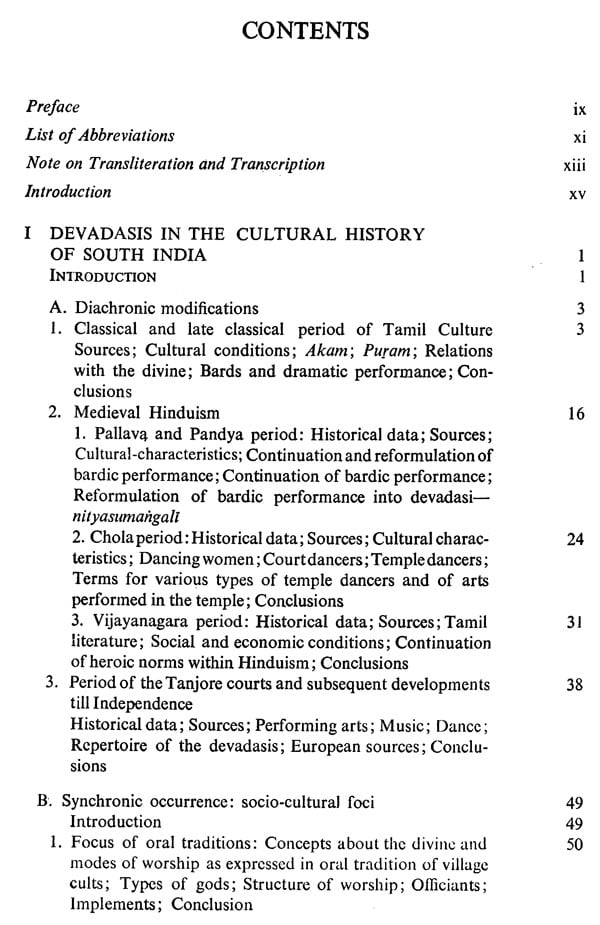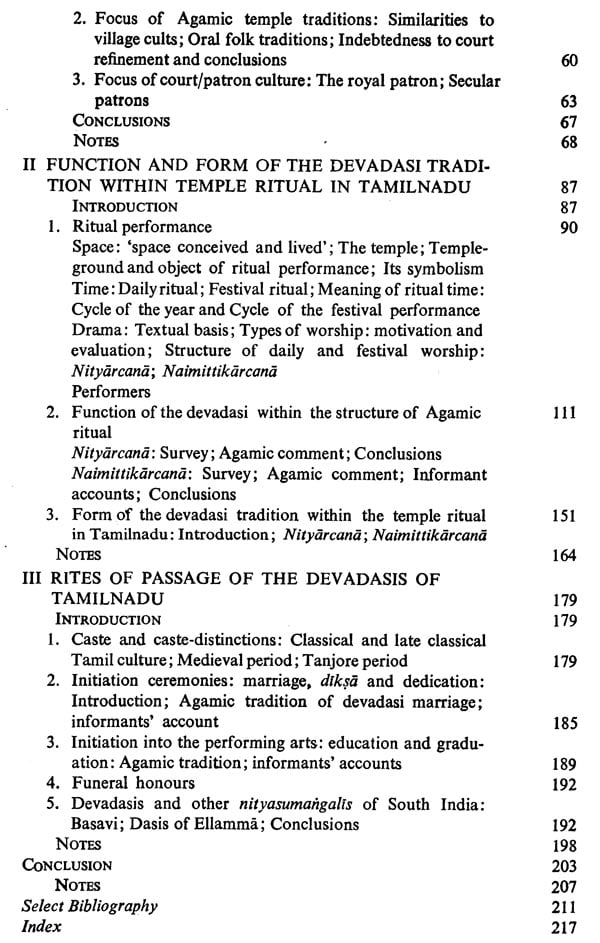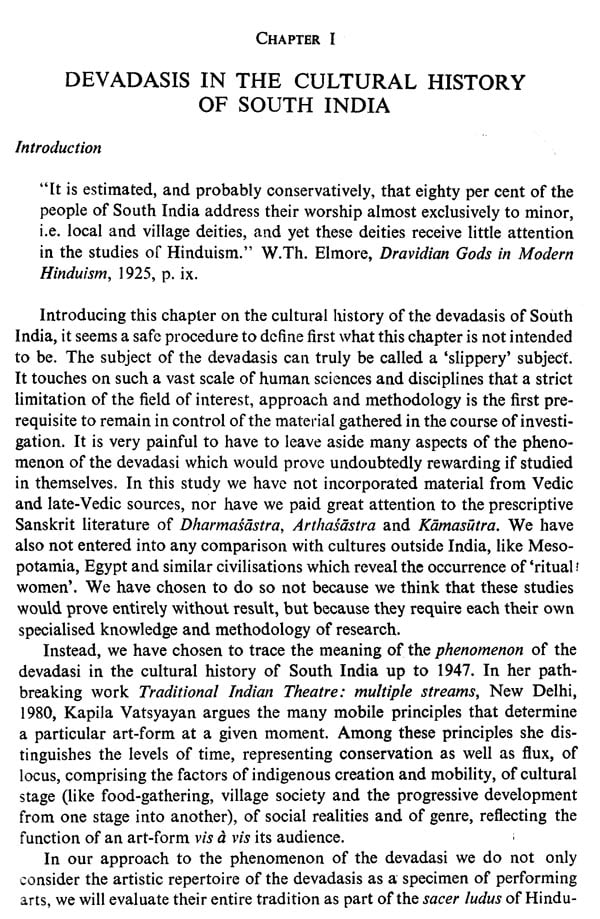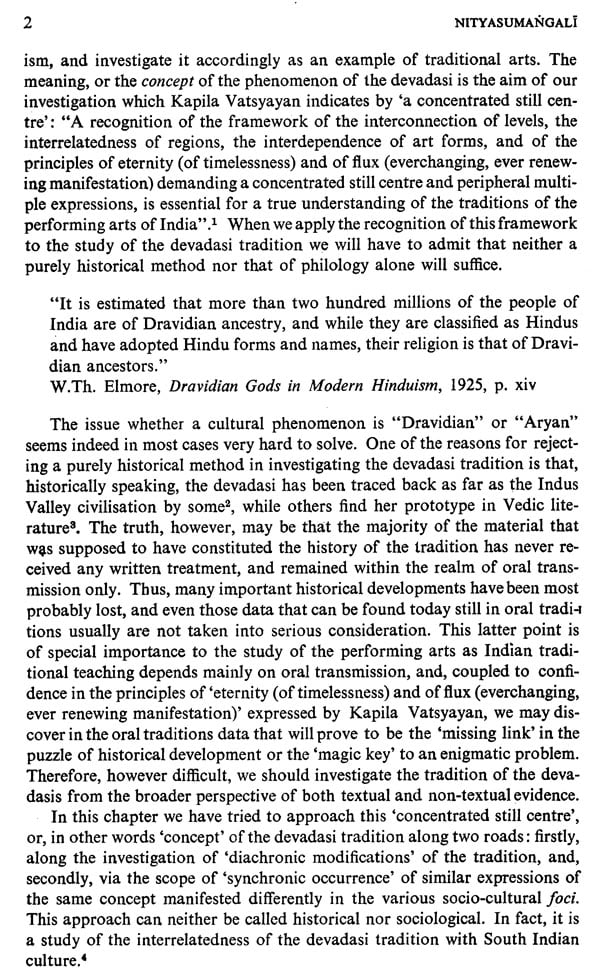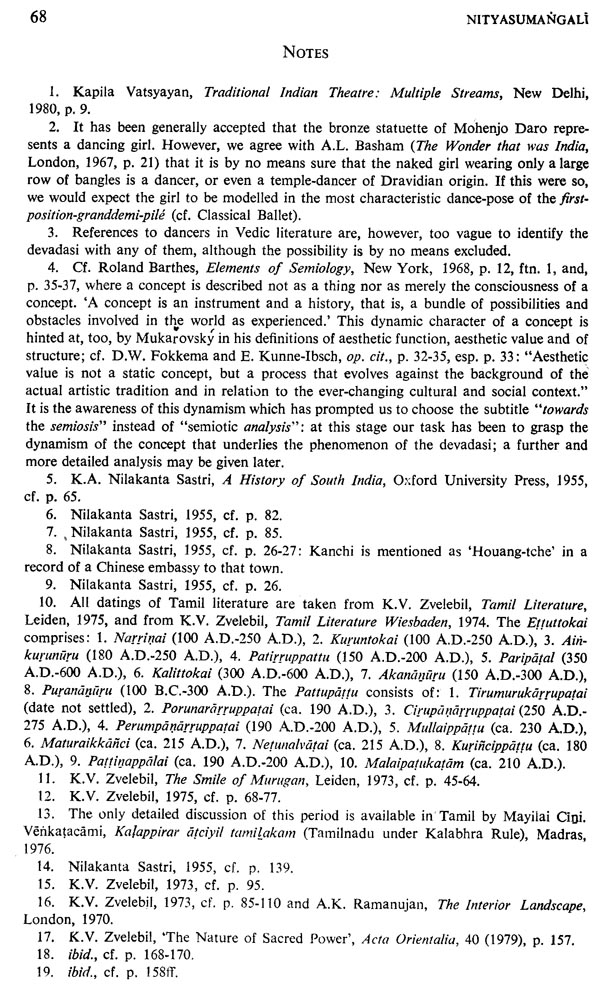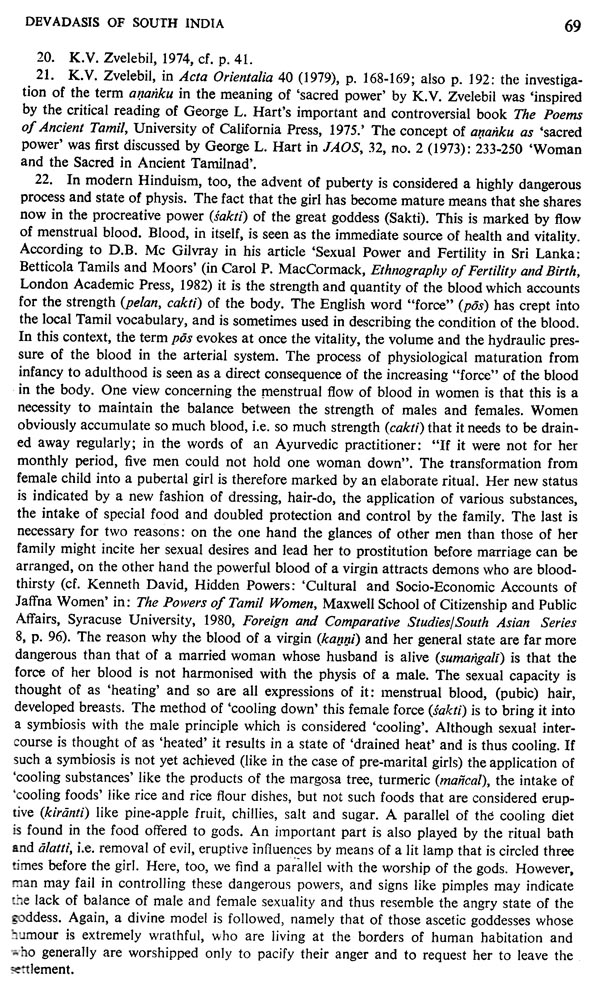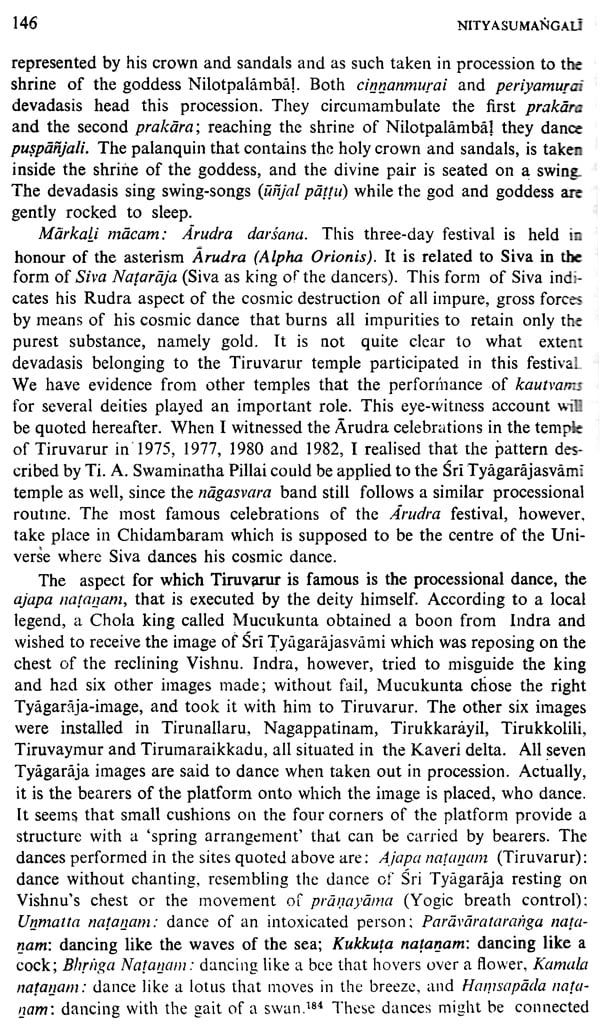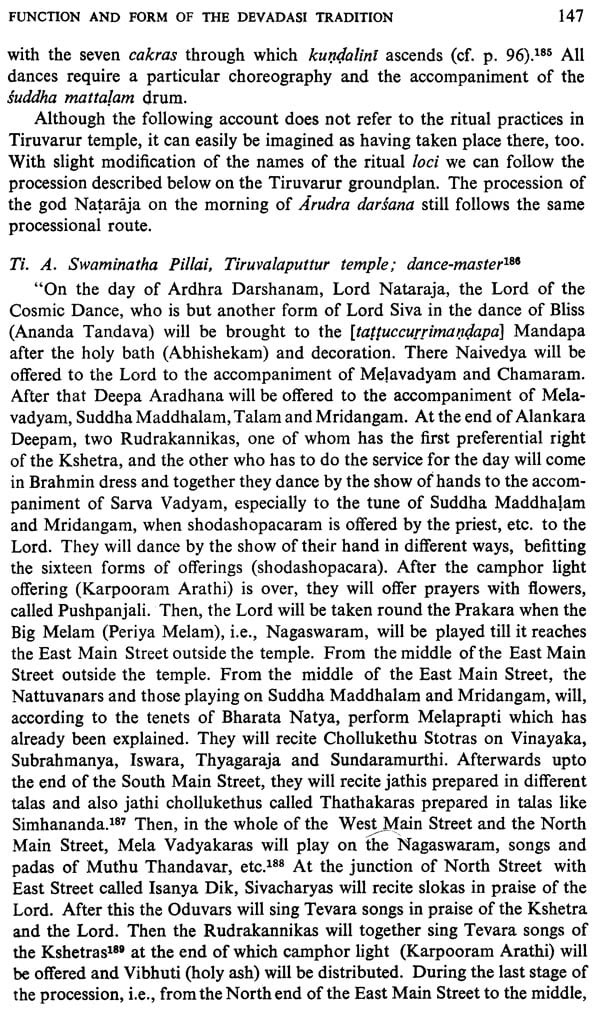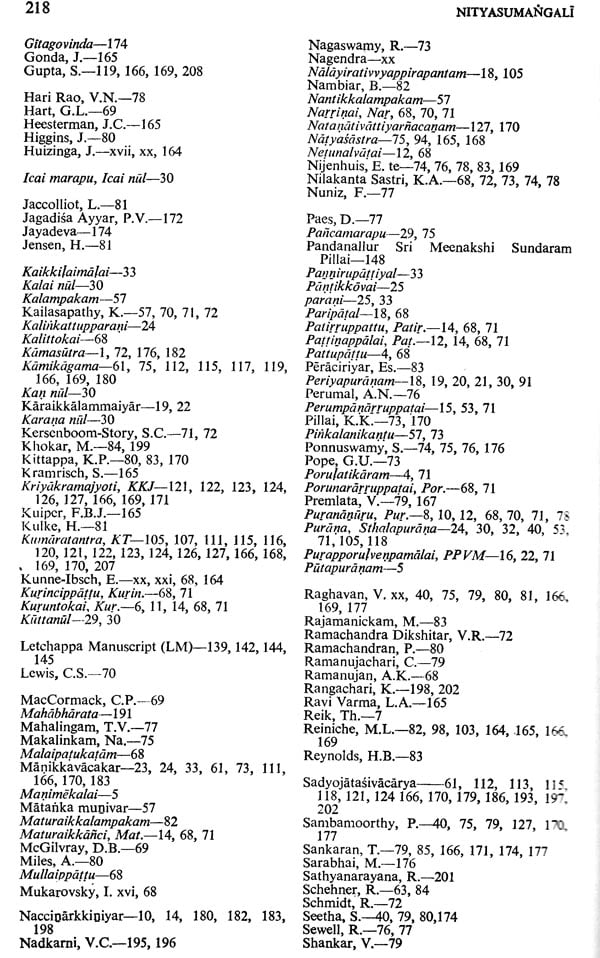
Nityasumangali (Devadasi Tradition in South India)
Book Specification
| Item Code: | NAT824 |
| Author: | Saskia C. Kersenboom |
| Publisher: | Motilal Banarsidass Publishers Pvt. Ltd. |
| Language: | ENGLISH |
| Edition: | 2016 |
| ISBN: | 9788120815278 |
| Pages: | 226 |
| Cover: | PAPERBACK |
| Other Details | 9.00 X 6.00 inch |
| Weight | 300 gm |
Book Description
The phenomenon of the devadasi has suffered greatly from faulty, culture-bound evaluations. The present monograph does not aim at judging these earlier evaluations, nor does it claim to give a 'truly objective' description of what the devadasi tradition was; it rather tries to follow the inherent mode of thought, namely, what the devadasi tradition meant within the frame of Hinduism, and its transformation into a living cultural phenomenon functioning significantly in the context of the Hindu tradition. In this attempt the author has first investigated the concept of the devadasi as found in the cultural history of South India, especially of Tamilnadu. Hereafter the function and form of the devadasi tradition are examined within the Temple Ritual of Tamilnadu. Data from Sanskrit Agamas, commentaries, Tamil sources, informant& accounts and from the actual repertoire of the devadasi's have been woven into a coherent structure. Finally, it is the devadasi herself, as a ritual person, who is the most significant marker of her tradition. The rites of passage that transform an ordinary girl into a devadasi, her wedding and artistic training and her funeral honours are described in the last chapter. In short, this is not the study of the fact of the devadasi tradition, but of its meaning and the mode of production of that meaning.
DR SASICIA KERSENBOOM (born February, 1953 Utrecht, The Netherlands) is an Associate Professor of Theatre Studies, University of Amsterdam. She studied Indology at the University of Utrecht. She obtained her Ph.D. in Dravidology under the guidance of Prof. Dr. K.V. She is trained in Classical Bharata Natyam by Mrs. Nandini Ramani and studied Karnatic vocal music with Shri B. -Krishnamoorthy. From Smt. P. Ranganayaki Cunnan she inherited the repertoire of songs and dances as practiced by the devadasis of Sri Subramanya Temple at Tirupati.- This combination prompts her to investigate and experiment with interactive multimedia as representation and learning tool for Performance Practices, as well as with Performative modes in Museum Exhibitions (2008-09, Zuerich Museum Rietberg Shiva Nataraja, the Cosmic Dancer), and intercultural dramaturgy/choreography (p.e. International Dance Theater, Amsterdam, 1997, 2007). She has taught at several universities in Europe, USA and India. Dr Kersenboom is also Director of Paraniparai Foundation for research, practice and sustainable development of local traditional Performing Arts of Tamilnadu, South India. She has just initiated a long-term project 'Murai - the Right to Perform' with the Indira Gandhi National Centre for the Arts (New Delhi, India) under the UNDP scheme of UNESCO that should lead to the status of Intangible Heritage for the Melakkaran community of temple musicians. Her publications include Nityasumangali: Devadasi Tradition in South India (MLBD, 1984) and Word, Sound, Image, the Lift of the Tamil Text with an interactive CD-i (1995, Oxford, Berg Publishers/ Philips Media).
Utter the word, and your tongue will be set on fire", with this warning parents instructed their children at the beginning of our century to keep a safe distance from the devadasis and their community. Now, the tide has turned, and the devadasis are rapidly becoming an object of romantic reminiscences of the past. No doubt, the topic is still enigmatic and controversial, even today. Actually, the tradition of the devadasis forms an intimate aspect of Hinduism that is little noticed, known and understood by outsiders. This study does not aim to give a sociological, historical or philological description of this phenomenon. It rather attempts to understand it from within the Hindu tradition. This perilous approach has followed three roads: 1. textual study of mainly Sanskrit and Tamil sources, 2. practical training in the performing arts of the devadasis and study of the underlying aesthetic theories, and 3. field-work: living in a Hindu family, participating in their rites and rituals, and a long-standing, warm friendship with the informants. This method induced me to abandon my initial view of the devadasis as `sacred artists' and led to the formulation of the concept of the devadasi as a nityaswnangali: an ever-auspicious female. This concept forms the hypo-thesis of this study and provides the title for this publication. The present monograph is based on my Ph.D thesis which was completed under the guidance of Prof. Dr. Kamil V. Zvelebil and accepted in 1984 by the University of Utrecht. However, my involvement in the devadasis dates back to 1975 when I witnessed for the first time the festival of Arudra Dar-4ana held in the great temple of Tiruvarur. This festival left an ineffaceable impression on my mind and sensibilities, as the dramatic force of Hinduism revealed itself in full splendour. In that year, too, Smt. Nandini Ramani, daughter of Dr. V. Raghavan and student of Smt. T. Balasarasvati since 1958, commenced my training in Classical Bharata Natyam. This road I followed ever since. It is with a feeling of deep gratitude and of profound sadness that I realize that the basis of my acquaintance with living Hindu tradition was laid by three representatives of the "old world", each great in their own way, v. hose demise marks the end of an entire era; an era that cannot be per-petuated since the surrounding world has changed too much to appreciate their greatness. The immense scholarship of Dr. V. Raghavan, his kindness in teaching me, the hospitality and generosity of a true aristocrat and devotee, Tiru V.S. Tyagaraja Mudaliar, and the uncompromising involvement of the great artist Smt. T. Balasarasvati: they leave us no successor of their magnitude. The gift of knowledge (vidylidana) is the most precious one to receive; especially in our times. Therefore I express with deep gratitude my indebtedness to all my teachers in Europe, especially to Prof. Dr. J. Gonda, to Mrs. Dr. S. Gupta and to Mrs. Dr. E. te Nijenhuis.
**Contents and Sample Pages**
